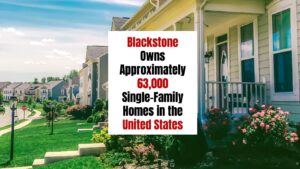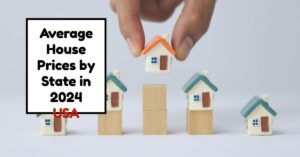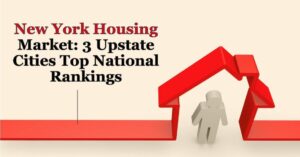Are you surprised to learn that Blackstone's dominance in the US single-family rental market is shaping how millions of Americans find housing? This isn't just about a big company; it's about the impact on your neighborhood, your community, and potentially, your ability to find affordable housing. Let's dive into the details of Blackstone's massive footprint and explore the implications for the future of the American rental market.
Blackstone's Dominance in the US Single-Family Rental Market: A Deep Dive
Blackstone: A Colossus in the Housing World
The Institute for Policy Studies (IPS) along with Popular Democracy published a report, Billionaire Blowback on Housing, which details how Wall Street's influence is affecting housing affordability. The report highlights how corporate landlords like Blackstone are concentrating their investments in lower-income communities of color, sometimes leading to concerns about practices like rent gouging and evictions.
Blackstone, the world's largest private equity firm, isn't just investing in stocks and bonds. They've become a major player in the US single-family rental market, owning an estimated over 63,000 single-family homes. That's a lot of houses! This massive portfolio, acquired through companies like Tricon Residential and Home Partners of America (HPA), positions Blackstone as a significant force shaping rental trends across the nation. But how did they get here, and what does it all mean?
The Rise of Blackstone in Single-Family Rentals: A Timeline
Blackstone's expansion into the single-family rental market wasn't an overnight phenomenon. They strategically built their portfolio through acquisitions and shrewd investments. A key moment was the purchase of Home Partners of America and Tricon Residential during the COVID-19 pandemic. These acquisitions added hundreds of thousands of residential units to their already impressive holdings, solidifying their position as the largest corporate landlord globally.
This growth is part of a larger trend. Wall Street, as a whole, is increasingly investing in residential real estate, fueled by low interest rates and the desire for steady rental income. But Blackstone's scale sets them apart. They are not just a player; they're a heavyweight champion in a game impacting millions.
As of June 30th, 2024, Blackstone boasted over $1 trillion in assets under management, highlighting their enormous financial power and influence within the market. This isn’t just theoretical; this translates to tangible control over a substantial portion of the nation's housing stock.
Blackstone's Portfolio: Beyond Single-Family Homes
While their single-family rental holdings are staggering, Blackstone’s real estate empire extends far beyond just houses. They own:
- Multifamily apartment units: An estimated 149,000 units are under their control, further expanding their reach in the rental market.
- Mobile home parks: Through Treehouse Communities, Blackstone owns 70 parks with 13,000 lots, representing another segment of the affordable housing market.
- Student housing: American Campus Communities, a Blackstone subsidiary, owned 144,300 beds in 205 properties in 2022.
- Affordable Housing: Blackstone also claims to have a significant presence in affordable housing, citing over 95,000 units, mainly leveraging the Low-Income Housing Tax Credit. However, critics question the sincerity of their commitment to affordable housing, citing their actions against rent control measures.
Table 1: Breakdown of Blackstone's Real Estate Holdings (Approximate Figures)
| Property Type | Number of Units/Lots/Beds |
|---|---|
| Single-Family Homes | >63,000 |
| Multifamily Apartments | 149,000 |
| Mobile Home Park Lots | 13,000 |
| Student Housing Beds | 144,300 |
| Total Residential Units | >369,300 |
(Note: These figures are based on publicly available data and may not be entirely precise.)
The Impacts of Blackstone's Dominance
Blackstone's massive holdings have sparked considerable debate and concern. While they argue that they provide needed housing and generate jobs, critics point to several potential downsides:
- Increased rents: The sheer scale of Blackstone's ownership might influence market pricing, potentially pushing rents upward, especially in already-expensive areas. This is something I've personally seen impacting communities, pushing out families who simply can no longer afford the rising costs.
- Evictions: Reports from organizations like the Institute for Policy Studies have raised concerns about higher eviction rates within properties owned by Blackstone subsidiaries like HPA. They highlight a pattern of aggressive eviction practices, particularly in lower-income communities of color.
- Lack of affordable housing: While Blackstone invests in some affordable housing projects, critics argue that their overall impact on the market contributes to a shortage of affordable options. The company's opposition to rent control initiatives further fuels these concerns.
- Reduced local control: A large corporate landlord like Blackstone might have less concern for the specific needs of a particular community, compared to smaller, local landlords. This can lead to a sense of disconnect between residents and property management.
Blackstone's Response and Counterarguments
Blackstone defends its practices by pointing to their investments in various types of housing, including affordable units. They also highlight the jobs they create and the capital they inject into the housing market. Furthermore, they argue that they’re providing needed housing and improving properties through renovations.
However, these counterarguments don't fully address the concerns about rising rents, evictions, and the lack of truly affordable housing options. The scale of their holdings, combined with documented incidents of aggressive business practices, raises legitimate questions about the long-term effects on communities across the nation.
The Future of Blackstone and the Single-Family Rental Market
The future of Blackstone’s role in the single-family rental market is uncertain, but several factors will likely play a key role:
- Interest rate fluctuations: Changes in interest rates will undoubtedly affect Blackstone’s investment strategies and could impact their expansion or contraction in the rental market.
- Regulatory changes: Government regulations and policies on housing, rent control, and tenant rights will influence how Blackstone operates and invests in the future.
- Public pressure: Public outcry and ongoing scrutiny of large corporate landlords will continue to shape the narrative around Blackstone’s practices.
- Economic conditions: Broad economic shifts, such as recessions or booms, will have major implications on both the rental market and Blackstone’s ability to maintain and expand its portfolio.
Partner with Norada, Your Trusted Source for Turnkey Investment Properties
Discover high-quality, ready-to-rent properties designed to deliver consistent returns. Contact us today to expand your real estate portfolio with confidence.
Reach out to our investment counselors:
(949) 218-6668 | (800) 611-3060
Conclusion: A Complex Issue with No Easy Answers
Blackstone's dominance in the US single-family rental market is a complex issue with significant implications for millions of Americans. While they provide a necessary function in the housing sector, their influence raises concerns about affordability, evictions, and community impact.
The ongoing debate highlights the need for a deeper understanding of the interplay between private equity, affordable housing, and the well-being of our communities. The conversation needs to continue, with greater transparency and accountability from major players like Blackstone, and stronger protection for tenants’ rights.
Recommended Read:
- Billionaire Landlords Are Worsening the Housing Crisis in America
- Will Federal Cap on Rent Hikes Solve or Worsen Housing Affordability?
- Will Housing Affordability Improve in 2024?
- Biden's 5% Rent Cap Plan Will Provide Relief for Renters Amid Housing Crisis
- Best Time to Buy a Home in 2024 is From Sept 29 to Oct 5
- Best Time to Buy a House in the US: Timing Your Purchase
- Should I Buy A House Now Or Wait Until Later 2024? It a Good Time?
- Is Now a Good Time to Buy a House with Cash
- Is It a Bad Time to Buy a House?
- Is it a Good Time to Buy a House in California in 2024?
- Is It a Good Time to Sell a House or Should I Wait in 2024?
- Is Now a Good Time to Invest in Rental Property (2024)?
- Is 2024 a Good Time to Buy an Investment Property?











